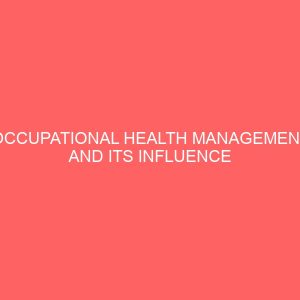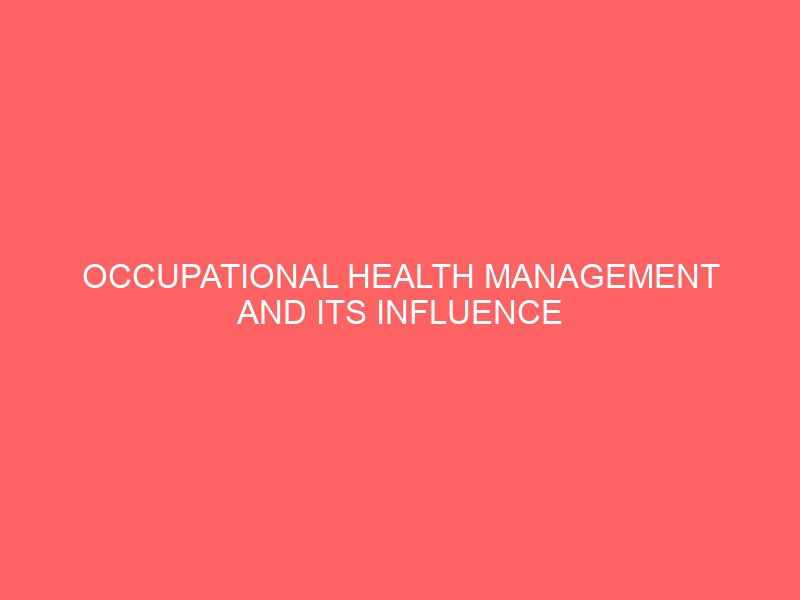Description
CHAPTER ONE
INTRODUCTION
1.1 Background of the Study
The health and safety (H & S) of employees is a very significant issue to consider with relation to the attainment of organizational goals and to see to employee’s productivity. Health and safety management are made up of policies and programs, concerned with protecting employees in an organization as they perform their specific activities as such protection is against hazards. With limited resources to help reduce occupational injuries, companies struggle with how to best focus these resources to achieve the greatest reduction in injuries for the optimal cost. Safety culture has been identified as a critical factor that sets the tone for importance of safety within an organization (Otoole, 2002).
International Labor Organization (ILO, 2012) reported that, every day, 6,300 people die as a result of occupational accidents of work-related diseases, where more than 2.3 million deaths are recorded per year, 317 million accidents occur on the job annually as well, many of these problems result in extended absences of workers form work which affects productivity to a large extent.
A healthy and safe workforce is an essential component for any business to run successfully. This is evident in the enormous interest by organizations in the activities related to Occupational Health Management which involves, safety practices, as if properly cared about, can lead to enhancing employee’s productivity.
It is a known fact that profit maximization serves as the key/core objective for setting up business organizations (Bamiduro, 2006); however, in achieving this objective, there is the need to consider the welfare and safety of workers in the organization. Considering the welfare and safety of employees in order to boost productivity and profitability, hazard must be minimized or prevented because it serves as a negative catalyst for declined productivity.
The international labor organization (ILO, 1950), defined hazards as a condition with the potential of causing an accident, leading to injury, damage or even both. In any event of occupational hazard, there is the possibility of causing an accident which may directly or indirectly lead to declined productivity.
Any productive oriented organization must assess the level of the plants and machinery, as well as other equipment’s and tools used for productive purposes in order to educate employees on how to effectively handle and operate the equipment’s. It is therefore necessary that carelessness and ignorance of machinery operations may increase the likely hood of hazard which tends to reduce employee’s productivity. It is therefore necessary for organizations to educate and enlighten their employees in order to reduce the effect of hazards.
1.2 Statement of the problem
Cases of occupational hazards in Nigeria have been on the increase in recent times and no significant attention seems to be paid to it. With increase in sophistication of machines and equipment coupled with less interest in staff training and quest for higher profits, incidence of accidents at work have blossom.
Occupational health does not only deal with occupational hazards causing accidents and occupational diseases but also includes all kinds of factors at work or related to working conditions that may cause or contribute to diseases or deviation from good health, the issue of hazards goes beyond the home and industries but also penetrate into every sphere of human life.
Although the benefits of effective H & S management have been well documented (Pollitt, 2011), some organizations especially those in developing countries like Nigeria still aim at maintaining or increasing productivity and profitability at the expense of employee health and safety thereby reducing employee job performance. With increasing industrialization and its consequent increase in industrial accidents and exposure to dangerous chemicals with their accompanying health implications for employees and others, the issue of health and safety management has become more pressing than ever.
It is on this backdrop, that this study is carried out to understand how Occupational Health Management, can Influence Employees Productivity, with focus on Food Manufacturing industries especially UAC foods, Lagos.
1.3 Aim and Objectives of the study
The aim of this study is to analyze Occupational Health Management and Its Influence on Employees Productivity especially in food Manufacturing Companies.
The specific objectives of this study are as follows;
- To understand the key concepts that have to do with occupational health management.
- To examine the benefits/importance of occupational health in organizations.
- To know how effective enforcement of Organizational Health Safety has been in Nigerian organizations.
- To determine the influence of Occupational Health and Safety training on employees’ performance in organizations.
- To examine the influence of employees’ attitudes towards occupational health and safety in organizations.
- To assess the attitude of management towards their employee’s occupational health.
1.4 Research Questions
The research questions key to this study are as follows;
- Do manufacturing companies in Nigeria have provisions that encourage proper health and safety practices?
- Are their challenges in implementing occupational health and safety practices in organizations?
- Does occupational health and safety have any value on employee’s productivity?
1.5 Research hypotheses
The following research hypotheses were formulated to achieve the objectives of the study;
H0: Manufacturing companies in Nigeria have no provisions that encourage proper health and safety practices.
H1: Manufacturing companies in Nigeria have provisions that encourage proper health and safety practices.
H0: Occupational health and safety does not have any value on employee’s productivity.
H1: Occupational health and safety has value on employee’s productivity.
1.6 Significance of the study
The world has turned into a global village and has attracted liberalization leading to competitiveness in all the industries. This has led organizations to strive hard to be productive enough. It is therefore hoped that this study will yield data and information that will be useful in managing employees’ occupational health and safety. The study will also be useful in modern management process which is faced with the problem of balancing individual’s and organizational expectations. The findings of the study will also be expected to contribute towards the establishment of effective occupational health and safety practices at work place to enable employee comply with the rapid change brought in technology and enhance their productivity. The study will also help the organizations overcome the common perception that the occupational health and safety practices is a compliance of employee welfare issue and use the initiative in this area to add value to the organization. The findings may also assist employees to discover their responsibilities of adhering to health and safety rules and regulations. Organizations will also recognize that occupational health and safety of employees influence level of productivity. Based on the data collected and information analyzed and interpreted as well as conclusions and recommendations, the study will also form a basis for further researches. This will contribute significantly to the world of management through generation of new knowledge.
1.7 Scope of the study
The scope of this study is on Lagos state as there are a lot of manufacturing companies and workers.
1.8 Limitation of the study
The research comes with a few challenges which include ability to source relevant literatures to substantially back this research findings, and financial expenses incurred in putting this research together.
1.9 Definition of Terms
The following are relevant definitions as regards to this study gotten from Oxford online dictionary
- Occupation: A job or profession.
- Safety: The condition of being protected from or unlikely to cause danger, risk, or injury.
- Health: The state of being free from illness or injury.
- Health and Safety: Regulations and procedures intended to prevent accident or injury in workplaces or public environments.
- Productivity: The effectiveness of productive effort, especially in industry, as measured in terms of the rate of output per unit of input.
- Management: The process of dealing with or controlling things or people.








Reviews
There are no reviews yet.